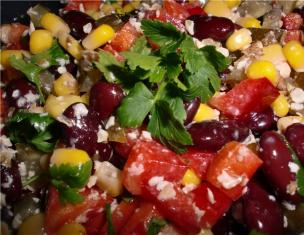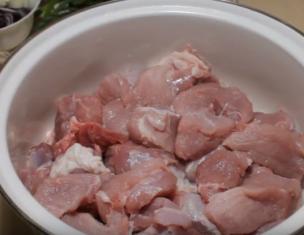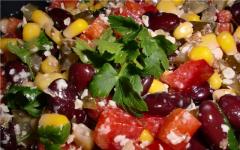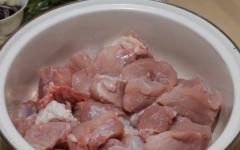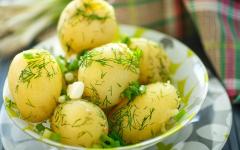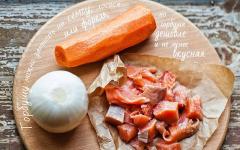Let's prepare the necessary ingredients for making grape confiture.
Pick all the berries from a bunch of grapes, sort out any debris, throw away bad and dried berries. Rinse the grapes with running water; it is better to do this in a colander - the water drains immediately.
Place the pan with grapes on low heat and, stirring occasionally, simmer for 10 minutes. There is no need for additional liquid; after washing, the berries are quite wet, and from the first minutes of cooking, juice will begin to release. Then, using a masher, crush the entire mass and simmer over low heat for another 10-15 minutes.
Place the resulting mass in a sieve with fine honeycomb (don’t forget to place a pan under the sieve). All the resulting liquid will drain into the pan.
Stir the berries in a sieve with a spoon and squeeze out as much juice and tender pulp as possible into the pan. A small part of the waste should remain in the sieve: grape skins and seeds.
Pour sugar into a saucepan with peeled grape mixture and put on fire. After boiling, reduce the heat to low and continue to simmer the confiture to the desired consistency, stirring occasionally. I simmered it for exactly an hour and my confiture came out quite thick.
Place the grape confiture into clean, sterile jars and cover with boiled lids. Turn upside down and leave until completely cool. You can store it either in the pantry or in a dark, cold basement.
A sweet, thick, aromatic treat for dessert is ready.
Delicate, tasty grape confiture will appeal to both children and adults. Try it!
Cook with love! Bon appetit!
Grape jam must be prepared from fresh fruits. The collected grape clusters need to be washed well and the berries separated from the branch. Remove wrinkled, spoiled grapes. It is convenient to wash the selected grapes by placing them in a colander.
Let the excess water drain and pour the grapes into the container in which you usually make jam. Deep enamel dishes are best suited for these purposes, and you need to stir the jam or jam with a wooden spoon.
Pour a third of a glass of water into the pan and place the grapes on the stove. Cook the berries over low heat until the grapes release juice. Now add one glass of granulated sugar. By the way, its quantity can be adjusted to your taste. Yes, and grape varieties have different acidity levels. If you wish, you can add a little more sugar than the specified amount.
Add the juice of half a lemon to the jam, gently stir the contents of the pan and turn up the heat. Let the grapes simmer for 10-15 minutes. During this time, the berries should burst and lose their shape. This means it’s time to strain our future jam.
Place gauze of a slightly larger diameter on a colander. Place the colander itself on the pan. Pour the cooked grapes into the prepared structure. 
Use a spoon or masher to crush the berries to extract the juice. Now connect the free ends of the gauze. Roll them up to form a pouch. The more you twist the ends of the gauze, the more juice you can squeeze out of the grapes. 
The released juice will drain through the colander into the container on which it stands. Pour the juice back into the pan and place it over low heat (to prevent the jam from burning).
Now all that’s left to do is boil the jam to the consistency you want. This may take twenty to thirty minutes. Be sure to stir the jam from time to time. Please note that the jam will become slightly thicker as it cools.
Jam made from Isabella grapes with seeds is very aromatic and pleasant to the taste. Boil it a little longer, and you will have an excellent filling for sweet pies. Just imagine what wonderful aromas your home will one day be filled with.
Remove the finished jam from the pan and let it stand for a while and cool. At this time, prepare the jars. Rinse them thoroughly and dry them. It is believed that jam should be poured into warm jars, covered with lids and wrapped in a towel until completely cooled.
When compared in hue, richness and aroma with berry jams, grape jam is inferior without a fight. It has a slight sourness, a more than unobtrusive aftertaste, and, in extreme cases, astringency and a nutmeg “trail.” But there is also a place for delicate sweets on the table! For example, with any cheese, biscuits and toast. Like rhubarb, apples and pears, grapes gratefully accept spices, nuts, alcohol and chocolate. It can be enriched by flavoring.
It is clear that the color of grape jam is influenced by the source. Red-blue varieties will enhance the darkening, bringing them closer to brown and burgundy, while white clusters will give something between opal and greenish. To thicken more, add additional gelling agents - sometimes your own pectin is enough.
Cooking time: 60 minutes / Number of servings: approximately 400 g
Ingredients
- grapes 500 g
- granulated sugar 500 g
- citric acid 3 g

Preparation
Big photos Small photos
We carefully examine the grapes - we do not take spoiled, rotten grapes for long-term storage. Therefore, we study the bunch; illiquid ones may be hiding somewhere inside.
Before cooking, be sure to rinse in cold water. Always wash, even if you know that the bunches grew at a height and did not touch the ground. We tear them off the branches one by one and place them in a bowl of water. Throw it in and accidentally crush it with your fingers; it will do for grated jam. The main thing is to keep it in the water for a while, in case small insects remain. In addition, the fruits undergo processing and, if externally clean, can be covered with a waxy, imperceptible coating. Leave for 5-10 minutes, then send it under running water once again and rinse, discarding it in a colander.

The most difficult part of the recipe is removing the seeds. You need to cut each “pea”, pry it off and remove the seeds without pulp. The variety decides a lot. Large grapes with few seeds in the core are easier to cut. There is a very, very small one, a solid shell, a minimum of juice-pulp and only seeds. I took the path of least resistance by purchasing sultanas, a famous seedless grape. I got a large one, with thin delicate skin and pleasant sweetness. Even if there are no seeds inside the grapes, I recommend cutting them in half or using some other method, maybe crushing them. We need moisture, a lot of juice, with which sugar dissolves faster.

Dessert, too sweet grapes are best seasoned with a little citric acid or freshly squeezed lemon juice. This will balance the taste balance, and canning for a long period will take place without fermentation. Let me remind you that acid is used in winter preparations not only as a flavor enhancer, but also as a preservative. Mix fruit slices with ultra sour granules. Try it, if there is a lack of sourness, gradually increase the amount of citric acid/lemon juice. But be careful not to overdo it.

Now it's sugar's turn. I take 1 to 1. I store it for a short time, on the refrigerator shelf, and serve it with nearby pancakes, desserts and bread toasts for tea. The jar is designed for about a week without gluttony.
Stir granulated sugar and grape halves, lift all layers - from bottom to top. Cover with gauze and leave at room temperature for a couple of hours. The smaller the sugar grains, the faster the liquid will release and the sugar will dissolve. The juiciness of the fruit also affects it. Periodically we approach the bowl and shake, speeding up the process of juice release. In my example, it took 3 hours - the grapes were floating in the sweet liquid, and there were almost no sugar crystals left.

Place in a convenient cooking container and bring the mixture to an active boil at maximum heat. Immediately reduce the heat to low, do not install the lid and stir quite often with a wooden spatula - remove the clots from the walls so that the burnt caramel does not spoil the quality of the delicacy.

The grapes quickly lighten and first swell in volume - they are steamed with hot sugar syrup. Continue cooking for the next 20-30 minutes. If the fruit-sugar weight is large, cook in wide enamel basins so that the diameter for the steam to escape is large. Then the time increases. If the weight of the components is low, an ordinary ladle is suitable and half an hour from the moment of boiling.

Do not let the syrup darken too much - do not overcook the grape jam. There will be nothing left except sugariness and caramel. After half an hour, my sultana halves shriveled, became saturated with viscous sweetness and became translucent. Remove from the stove.

You could also leave grape jam - “glass” pieces of grapes in nectar, also delicious. But today we’re talking about grape jam, so let’s grind it to the desired grain size. I like tangible fruit fragments. To be safe, after grinding, boil again and immediately pour into sterile jars. Close and cool.
After cooling, place homemade grape jam in the refrigerator. Serve for breakfast, afternoon tea and tea. Bon appetit and full bins!


Grape jam is a very tasty delicacy. When the abundance of grapes makes you no longer want to look at them, let alone eat them, it is better to prepare a couple of jars of jam or preserves for the winter. Grape jam, the recipe with a photo of which I invite you to study and try, is easy to prepare. Therefore, even those new to cooking should not be afraid, but cook.
Ingredients:
- ripe, juicy grapes – 1 kg;
- granulated sugar – 550-570 g;
- lemon – 0.5 pcs. medium size.
1. To prepare more grape lemon jam for the winter, proportionally increase the amount of ingredients indicated in the list. Separate each grape from the grape. Throw away any dead, rotten or deformed berries. Rinse the grapes well and place in a colander to drain all the liquid. Then transfer to a basin or other container for making jam or preserves. Place the grapes over moderate heat and cook, stirring, until the juice releases. As for seeds: it is better to use grapes without them. But if you don’t have to choose, then it’s more convenient and easiest to then strain the almost finished delicacy from them. You still have to get rid of the lemon slices. 
2. Speaking of lemon. Wash it well and pour boiling water over it. Cut off half the fruit. The second half, as you may have guessed, we won’t need. Cut the lemon half into slices. It is advisable to immediately remove the seeds. 
3. When the grapes release juice, add lemon. Lemon will not only make the taste of the jam more interesting and prevent excessive cloying, but will also be a natural preservative that will allow the grape jam to wait for tasting. 
4. Add sugar. Another ancient preservative and flavor enhancer. Add the entire portion of sugar at once and return the container with jam to the heat. Simmer over low heat for about 15 minutes. Press the almost finished jam through a fine sieve to remove the lemon and grape seeds. Return to the heat and cook for another 10 minutes. Check the jam for doneness. For this you will need a saucer. Place a small amount of jam on it and make a groove in the middle. If it doesn't swim, the jam is ready. You can try! 
And if you plan to prepare grape jam for the winter, put it in sterilized half-liter jars. 
Seal with boiled lids. Take it out of the sun's reach. Turn it upside down and wrap it in a blanket. The next day you can transfer it to storage in the basement or pantry.
Happy preparations. 
Try also
When the time comes to make preparations for the winter, you definitely need to take care of a delicious accompaniment to winter evening tea parties. Grape jam is a sweet and delicate delicacy that can be an independent dish, a base for baking, marinades and sauces, and can also be used as an additive to cheeses, toasts, and biscuits. You can prepare it from any variety, you can even mix it. Both overripe and cracked fruits and unripe ones are suitable. The main thing is not to use rotten and spoiled ones - this will harm your health and spoil the taste.
Isabella grape jam
Ingredients:
- 1.5 kg Isabella grapes
- 600 g sugar
- Juice of one lemon
Preparation:
Process the berries. To do this, sort and rinse well. Place in a saucepan and add water, cook for 5-7 minutes. After this they will become soft and grind well. Grind the pulp through a sieve and transfer to a saucepan. Add sugar and lemon juice. Heat over medium heat and bring to a boil. Simmer until well thickened, about 25 minutes. Place in sterile jars, roll up, and wrap until completely cool.
Grape jam for the winter. Recipe for cooking from unripe berries.
When the fruits have not had time to accumulate sugar and ripen, they do not need to be thrown away, they need to be prepared according to our recipe!
Ingredients:
- 2 kg grapes
- 1 kg sugar
- Lemon
Preparation:
 Prepare the berries, rinse and sort. Boil in a small amount of water to easily remove the seeds. Grind the berries boiled for several minutes through a sieve. Transfer the mixture into a saucepan, add sugar and heat slowly. Cut the peeled lemon into small slices and add to the pan. Boil for about 20 minutes until fully cooked. Delicious grape jam is ready! Place in sterile jars, screw, cover and leave until completely cool.
Prepare the berries, rinse and sort. Boil in a small amount of water to easily remove the seeds. Grind the berries boiled for several minutes through a sieve. Transfer the mixture into a saucepan, add sugar and heat slowly. Cut the peeled lemon into small slices and add to the pan. Boil for about 20 minutes until fully cooked. Delicious grape jam is ready! Place in sterile jars, screw, cover and leave until completely cool.
When preparing grape preparations, only the pulp of the berries is usually used. But the skin, which is often thrown away, contains many useful substances. Including pectin, which is responsible for stabilizing the product. Therefore, using grape skins will not only make the product healthier, but also improve its consistency.
How to determine the readiness of grape jam
When cooking and boiling, the jam is liquid, so it is not always clear whether it is ready or not. But there are several ways to accurately determine the degree of readiness of a dish:
- Remove a test spoon and place it on a cold saucer. Place in the refrigerator for a minute, remove and check for doneness.
- Directly in the pan, run a spoon over the contents and make a groove; the finished jam should not drain immediately.
- Scoop the jam into a spoon and try to pour it back. If the thickening is good, it will drain slowly. Therefore, the dish is ready.
There are many recipes for grape jam. In this article, we have selected for you the simplest and at the same time not trivial cooking methods. We hope you will like them.
 Popular and original recipes for peppers in…
Popular and original recipes for peppers in…
 Rules for growing grapes - choosing a variety, location,...
Rules for growing grapes - choosing a variety, location,...


